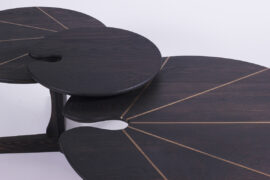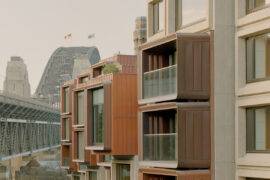Humans are emotional beings, it follows then that a human-centred design approach should spark an emotional response. Cove Design Studio’s Caroline Roberts believes so.

Bendigo Hospital by Bates Smart and Silver Thomas Hanley. Photo by Peter Clarke.
May 15th, 2019
Human-centred design, as the name implies, looks to human problems to solve through design. It puts the human experience and human needs front and centre. Following a talk as part of Melbourne Design Week, we continued this conversation with Caroline Roberts, an interior designer at Cove Design Studio. Here she shares her insights into the link between emotions, emotional intelligence and human-centred design.
Caroline Roberts: Surely, emotion is at the crux of human-centred design. Firstly, we as humans are animate beings with feelings and emotions and factoring this into design will lift any project beyond a place or space in which humans merely function. To illustrate this point, think of the design of a large public venue such as the MCG. The way humans move in and out of ‘the G’ at the end of a game can, to all intents and purposes, be modelled by engineers studying fluid mechanics. We could be likened to grains of sand in a funnel… but we’re not. Humans seek to do more than just function in their chosen environment. Humans benefit from interaction and connection, engaging the senses and thus promoting an emotional response from within tugs at the intangibles within us. This can come out as a sense of belonging, connection, nostalgia and fulfilment.
If the design of our built environment, and in particular the interiors with which we literally interact, can promote an emotional response, this will open our minds and engage our senses – leading to us be more open to being in the space, learning and feeling. When our senses are enlisted, we want to explore and linger rather than when we react negatively, where we close our minds and seek to exit the space. An awareness of this is vital, particularly in designing public buildings and spaces.
Emotional connection is a very important component to focus on in relation to the success of a design as, initially, it’s what fosters communication and understanding between the designer and client/user, and that’s before any plans are drawn. Once completed, a key measure of a project’s success is the emotional connection a user feels with the space. As an interior designer, we work at the human scale: a client who loves to cook may want to evoke memories of her Nonna’s kitchen in her new kitchen. This can be interpreted in a contemporary way with modern finishes but when distilled the essence of the brief was to create the same sense of warmth and comfort in the hub of the home.
I see emotional intelligence as an attribute that we develop as we mature. Certainly, as we develop as individuals and evolve as the human race increased opportunities to connect on an emotional level are what promotes our emotional intelligence. Designing spaces to facilitate and foster comfortable, safe human interactions is the first step. Cultural awareness, inclusivity and approachability are factors to address in the design.
Emotionally intelligent beings are aware of themselves and their self-worth and from this flows an ability to look outwardly and to empathise. Empathy will develop when everyday interactions with our built environment (such as public spaces – think toilets, transport, footpaths etc.) accommodate a diverse population and normalise facilities for, and enable, the presence of those different to ourselves (gender neutral toilets, multi-level basins, accessible lifts are all a great start).
In order to develop emotionally intelligent humans, it’s surely always best to start early, with the young and often. It’s natural then to focus on design for the home, fostering comfort and human interaction and progress to the bigger scale of learning spaces such as kindergartens, schools and all educational facilities. From there, public buildings and workplaces broaden the scope and we also need to include public spaces such as hospitals, prisons and transport – places we may find ourselves in when we are at our most vulnerable.
We think you might like our wrap of Wellness Spaces in 2019.
INDESIGN is on instagram
Follow @indesignlive
A searchable and comprehensive guide for specifying leading products and their suppliers
Keep up to date with the latest and greatest from our industry BFF's!

A curated exhibition in Frederiksstaden captures the spirit of Australian design
The new range features slabs with warm, earthy palettes that lend a sense of organic luxury to every space.

Gaggenau’s understated appliance fuses a carefully calibrated aesthetic of deliberate subtraction with an intuitive dynamism of culinary fluidity, unveiling a delightfully unrestricted spectrum of high-performing creativity.

How can design empower the individual in a workplace transforming from a place to an activity? Here, Design Director Joel Sampson reveals how prioritising human needs – including agency, privacy, pause and connection – and leveraging responsive spatial solutions like the Herman Miller Bay Work Pod is key to crafting engaging and radically inclusive hybrid environments.

Western Sydney University’s (WSU) School of Engineering, Design and Built Environment has partnered with Maxton Fox for a second year to present design students with a new kind of challenge.

The idea behind ubiquitous inclusivity is undoubtedly an appealing one, which is why universal and accessible design principles have been gaining so much traction in recent years. Here, two renowned design experts weigh in on utilising these principles to create accessible bathrooms – and share the design thinking underpinning the process.
The internet never sleeps! Here's the stuff you might have missed

The second installment in our three-part series on collaborations between the world’s best designers and the American Hardwood Export Council

The INDE.Awards 2025 has crowned Sirius Redevelopment by BVN as the winner of The Multi-Residential Building, sponsored by CULT. This ambitious project redefines urban living in Sydney’s historic Rocks precinct while preserving heritage, reducing embodied carbon, and elevating residential design.